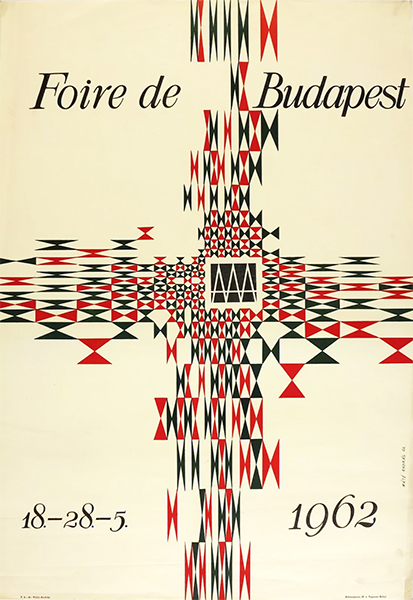
Description:
Decorative poster for the Budapest Fair (BNV) in 1962.
Budapest International Fair is a traditional event series. The first one was held in 1906, and even though it was a smaller scale happening it proved to be an efficient tool for promoting and selling local products. In the following years the event received greater attention. Stationery, toys, fancy goods, porcelain, footwear and other products were showcased. Later on foreign traders became allowed to participate, but only with products that were not available in Hungary and not with the purpose of selling but exchanging knowledge about certain subjects. The fair gradually became larger and larger but after the First World War the process slowed down. However, the fairs were still organized because those played a crucial role in the improvement of world trade. Hungary was among the most significant fair organizer countries in the 1920s. Although the economy crisis did have an effect on the fairs, simultaneously with the progress of the economy, the breakthrough came for BNV. Each year something new was introduced. In 1938 Phillips came out with their new television or three years later Italy presented the maquette for Termini railway station. During World War II no fairs were held, but the plan was to reestablish them. In 1950 the government of the de facto communist leader Mátyás Rákosi did not want to invest in the fairs, but 5 years later the ice had broken and the so-called Budapest Local Industry Fair was born. In 1962 the fair’s original concept was restored and so was the name: Budapest International Fair. This poster was created for the very first traditional International Fair in the socialist Hungary.
The communist government was initially against the fairs they soon realized that they could use it for their own purpose. The socialist politicians used all possible platforms for propaganda, where they had a chance to spread their excessively and falsely optimistic message about the improving economy of the country. The preface of the event’s catalogue says the following: “ [...] Since 1906, when the first fair was organized in Budapest, these events have gone through serious changes. They have received a new content - in the recent years - they became the ‘shop-window’ of the almost complete cross section of the constantly improving people’s economy of the already liberated socialist Hungary [...] The Hungarian economy presents products at the fair that sincerely demonstrate the quick development of various fields of the industry, the significant improvement of the quality of production techniques [...].” This quote reflects the typical attitude of the era - they tried to erase everything from the past, the times prior to the communist period. Those traditions, events, holidays that they couldn’t abolish were transformed and manipulated until it fitted their own image.
These BNV events testified the modernization of the country, the improvement of the quality of life that inevitably involved the idea of a new, modern applied art. This manifested in the application of a great variety of new techniques in poster art. On cultural posters clean, geometric, spheric and streamlined forms were the most dominant.
This atypical poster by András Máté is quite is made in op art style that wasn’t often applied by him. Pop art and op art emerged in Hungarian poster art in the 1960s when artists finally had a chance to experiment with a wider variety of techniques after the dark years of the obligatory socialist realist style. Op art is a non-figurative style based on visual effects achieved by the combination of basic geometric forms.
This manner was suitable for the poster genre. As stated in a contemporary article: “The influence of pop art and op art in fine art is minimal, and if we encounter it, it’s on posters, or other graphic design media or in fashion - the fields where society has already found modern taste”. The most famous Hungarian op art artist is Victor Vasarely, who created posters himself. His dream was art that was available for everyone. He believed that people needed fine art just as much as music, and he didn’t regard the 20th century as the time of unique art: he wanted to produce art that can be reproduced and is affordable for anyone. He didn’t consider himself a painter, he regarded ‘museum art’ obsolete and preferred applied art over it. Op art and poster art were both suitable to his vision. Initially these works perplexed the audience but by the 1950s it became very popular and appeared on numerous posters.
The posters designed for these international fairs played an important role in the birth of the emblem-like graphic design of the 1960s. Posters designed for these occasions were economic and disciplined. The puritan and clean manner became the standard style for the International Fairs. Some examples are: BNV 1966, BNV 1967, BNV 1969, BNV 1970.
The visual effect on this poster by Máté is attained by pairs of red and black triangles in different sizes and shapes adjusted at the top angles. They are arranged in a way that the middle looks like a magnet that magnetizes little particles from all around. The image symbolizes the significant importance of the fairs and the fact that it attracts masses of people from all around the world. The triangle pairs are smaller and more dense close to the center and a bit more scattered and bigger farther. This makes it look like masses of people captured from above rushing to one place from four directions, to a building for example and lining up at the doors. The poster neatly summarizes the magnitude and prestige of its subjects with a non-figurative, elegant visual language.











